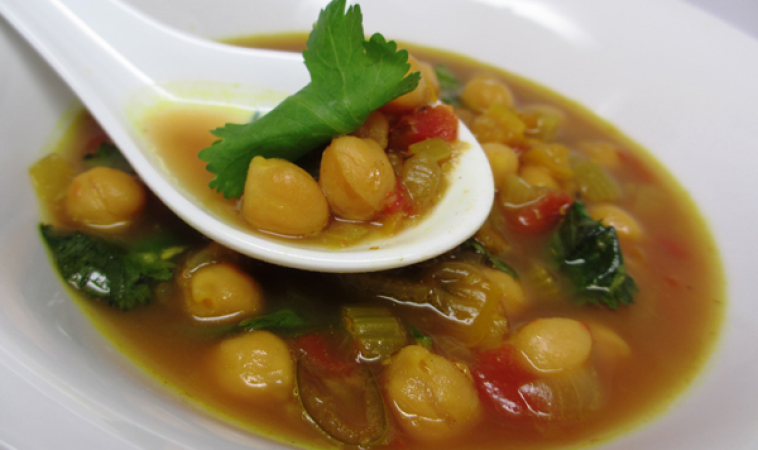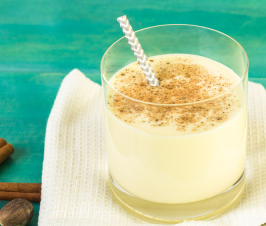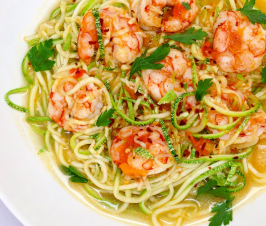Dr. Sarah Cimperman, ND
@DrCimperman
Amidst our busy lives, we do everything possible to spend less time on daily chores like cooking. But what we really should be doing is spending more time in the kitchen. Cooking nourishing meals is one the easiest and most effective ways to keep ourselves and our families in good health. According to a study from the National Institutes of Health, people who cook at home live longer than people who don’t, regardless of their knowledge of nutrition and physical ability to shop for food and prepare meals.1 Researchers found that people who cooked at home at least five times per week were 47 percent more likely to be alive ten years later, but even people who cooked less frequently saw benefits. The more frequently people cooked, the longer they lived.
One very basic and nourishing meal is soup. Moroccan Chickpea Soup with Leafy Greens contains all the components of a healthy meal – fiber, protein, and healthy fat – as well as restorative bone broth and anti-inflammatory herbs and spices. Ginger, garlic, onions, chili pepper, cinnamon, and cilantro have been shown to reduce inflammation in the body, lower fasting blood sugar and insulin levels, and improve blood sugar control.2,3 Turmeric fights inflammation too, and it’s a potent antioxidant. Studies show that turmeric helps detoxify cancer-causing chemicals,protects against free-radical (oxidative) damage, and increases the flow of bile from the liver,4 which is one of the body’s natural detoxification mechanisms.
Moroccan Chickpea Soup with Leafy Greens
This fragrant soup smells like a spice market in Morocco. It can be served as a flavorful first course or a hearty main dish. Warm up leftovers for a quick breakfast or an afternoon snack. You can eat it as is, simply garnished with fresh cilantro, or serve it a shallow bowl and top it with a fried egg or a piece of broiled fish. For a meatier dish, stir in chunks of leftover turkey or add some small lamb meatballs.
In this recipe I used a whole bunch of cilantro, not just as an herb, for flavor, but as a leafy green vegetable. Cilantro roots and stems have just as much flavor as the leaves, so I always use them too. If you prefer, substitute parsley or other leafy greens like spinach, chard, or kale, which may require some extra cooking time. For more authentic Moroccan flavor, use a preserved lemon (seeded and chopped) in place of a fresh lemon.
Ingredients:
- 1 tablespoon ghee (or substitute coconut oil)
- 1 medium onion, chopped, about 1 heaping cup
- 4 medium stalks celery, chopped, about 1 heaping cup
- 1 medium yellow bell pepper (or any color), chopped, about 1 heaping cup
- 1 or 2 chili peppers, any color, minced or finely sliced into thin rounds
- 1 cup dried chickpeas (garbanzo beans), pre-soaked in filtered water for 12 to 24 hours
- 1 cup chopped tomatoes and their juices
- ½ teaspoon sea salt
- ¼ teaspoon freshly ground peppercorn
- 1 packed teaspoon freshly grated ginger
- ½ teaspoon ground turmeric or 1 teaspoon freshly grated turmeric
- ½ teaspoon ground coriander seed
- ½ teaspoon ground cumin seed
- ¼ teaspoon ground cinnamon
- 6 cups bone broth (recipe follows)
- 1 fresh bay leaf or 2 dried ones
- 2 garlic cloves, grated
- 1 lemon, zest and juice
- 1 bunch cilantro, some leaves reserved for garnish and the rest finely chopped (leaves, stems, roots)
Directions:
- Melt the ghee in a heavy-bottomed soup pot or Dutch oven over medium heat. Add the onion, celery, bell pepper, and chili pepper to the pot. Cook, stirring occasionally, until the vegetables become soft and start to brown.
- Add the salt, pepper, ginger, turmeric, coriander, cumin, and cinnamon. Stir to coat the vegetables in the spices. Allow them to toast until they become aromatic, just a few minutes. While they toast, drain and rinse the chickpeas.
- Stir in the tomatoes and scrape up any brown bits on the bottom of the pot. Stir in the broth, bay, and drained chickpeas. Bring the mixture to a boil.
- Reduce the heat to low and simmer the soup slowly until the chickpeas are tender, about an hour, depending on how long they were soaked. Once the chickpeas are tender, turn off the heat and grate the garlic into the pot. Stir in the garlic, cover the pot, and allow it to sit for 10 minutes or more. The soup can be made up to this point a day or two in advance.
- Just before serving, re-heat the soup if necessary. Stir in the cilantro and lemon, then taste it for seasoning and make any necessary adjustments. Garnish with fresh cilantro and serve immediately.
Bone Broth
Bone broth has been revered as both food and medicine since ancient times. The nutrients and protein in bone broth are particularly well absorbed and they support the growth and repair of connective tissues in the body like bones, joints, blood vessels, and skin, while the gelatin acts as a natural digestive aid. Bone broth can be consumed regularly as a winter tonic or used as a healthy and flavorful base for soups, stews, and sauces. It’s always been popular with gourmet chefs, serious home cooks, and grandmas, but now bone broth is trending. Even New Yorkers can be spotted sipping it on the street from to-go cups instead of coffee.
Like all things, the quality of the finished product can only be as good as the raw materials, so use bones from animals raised on pasture, fed their natural diet, and never exposed to hormones, antibiotics, GMOs, pesticides, or other chemicals. This recipe calls for a turkey carcass plus the neck and giblets (save the liver for another use) but you can use bones from any wild, grass-fed, or pasture-raised animal. The marrow should be exposed but bones don’t need to end up in tiny pieces. They just need to fit into your pot. You can chop up smaller bones, like those from poultry, with kitchen shears or a sharp cleaver. Bigger bones require an electric saw (your butcher can cut them up for you) and longer cooking times, sometimes 24 hours in a slow cooker, but poultry bones make broth in about 4 to 5 hours.
I usually add dry beans to give my broth more nutrients and a bit more body. I also add a splash of vinegar because a small amount of acid will maximize the release of gelatin and minerals like calcium and magnesium from the bones as the broth simmers.
This recipe yields six to seven pints of broth. Alternatively, you can boil it down to concentrate it after you strain it, then portion it into ice cube molds and use them as you would bouillon cubes.
Ingredients:
- Carcass or bones, preferably with some meat left on them and marrow exposed, enough to fill your largest pot one-half to two-thirds full
- Several cups of vegetable trimmings or roughly chopped aromatic vegetables like celery, carrots, onion or leek tops
- A head of garlic cut in half through the “equator”
- A pinch of sea salt (not too much because you can adjust the seasoning later)
- 1 teaspoon whole peppercorns
- 1 fresh bay leaf or 2 dried bay leaves
- 1 or 2 dried chili peppers (optional)
- 1 handful of dried beans (adzuki, white, pinto), pre-soaked overnight
- Splash of apple cider vinegar
Directions:
- Add all of the ingredients to a large pot along with enough cold water to cover all of the contents generously, leaving some room at the top to prevent the broth from boiling over.
- Bring the mixture to a gentle boil over medium-high heat, then reduce the heat to the lowest setting. Cook the broth at a boil so gentle that just a few bubbles rise to the surface at a time. Skim off any foam that rises to the surface. Simmer the stock, tasting occasionally, until all the flavor has been extracted from the bones, about 4 to 5 hours for poultry bones.
- Cool the broth, strain it, and portion it into clean, labeled glass jars with tight-fitting lids and store them in the fridge. If you plan to freeze the stock, be sure to leave an inch of space at the top of each jar to allow for expansion and prevent cracking. After you fill the jars with broth, leave them in the fridge overnight to ensure that they are thoroughly chilled. The following day, transfer them to the freezer but leave the lids unscrewed. Allow them to freeze solid overnight. The following day, when the stock is completely frozen, screw on the lids.
References:
- Chen RC, Lee MS, Chang YH, and Wahlqvist ML. Cooking Frequency May Enhance Survival in Taiwanese Elderly. Public Health Nutrition 2012;15(7):1142-49.
- Ballali S, and Lanciai F. Functional Food and Diabetes: A Natural Way in Diabetes Prevention? International Journal of Food Sciences and Nutrition 2011;63 (Suppl 1):51-61.
- Rani MP, Padmakumari KP, Sankarikutty B, Cherian OL, Nisha VM, and Raghu KG. Inhibitory Potential of Ginger Extracts against Enzymes Linked to Type 2 Diabetes, Inflammation and Induced Oxidative Stress. International Journal of Food Sciences and Nutrition 2011;62(2):106-10.
- Nagabhushan M and Bhide SV. Curcumin as an Inhibitor of Cancer. Journal of the American College of Nutrition 1992;11(2):192-98.
- Boonjaraspinyo S, Boonmars T, Aromdee C, Puapairoj A, and Wu Z. Indirect Effect of a Turmeric Diet: Enhanced Bile Duct Proliferation in Syrian Hamsters with a Combination of Partial Obstruction by Opisthorchis Viverrini Infection and Inflammation by N-Nitrosodimethylamine Administration. Parasitology Research 2011;108(1):7-14.

















